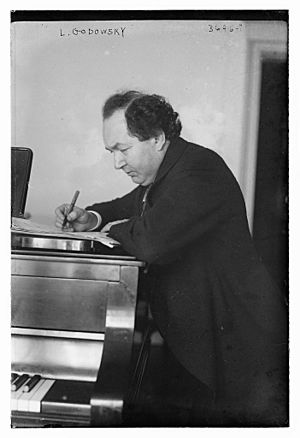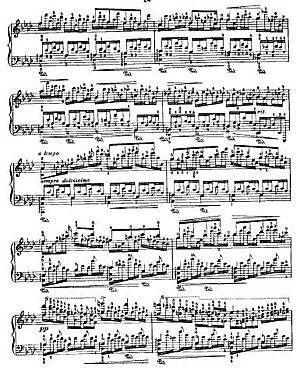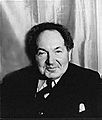Leopold Godowsky facts for kids
Leopold Godowsky was a famous super-talented pianist, composer, and teacher. He was born in Lithuania in 1870 and later became an American citizen. People thought he was one of the best performers of his time. He was known for teaching a special way of playing the piano that focused on using relaxed weight and efficient movements. His students, like Heinrich Neuhaus, continued to teach his methods.
Some musical giants even called him the "Buddha of the Piano." Another famous composer, Ferruccio Busoni, believed that Godowsky was one of the few composers who truly added important new ideas to piano music since Franz Liszt.
As a composer, Godowsky is most famous for his pieces like Java Suite, Triakontameron, and Passacaglia. He was also well-known for taking music by other composers and making his own amazing versions. His most famous work like this is the 53 Studies on Chopin's Études, which he worked on between 1894 and 1914.
Contents
Leopold Godowsky's Early Life and Career
Leopold Godowsky was born in a place called Žasliai, which is now in Lithuania. His parents were Jewish. His father, Mordkhel Godowsky, was a respected medical helper who sadly died when Leopold was only 18 months old during a cholera outbreak. Leopold was then raised by his mother and foster parents in Vilnius.
Leopold showed his amazing musical talent very early. By the age of five, he was already composing music and becoming skilled at both the piano and the violin. He gave his first concert when he was nine years old and soon after toured around Lithuania and East Prussia. Even though he had a few lessons as a child, Godowsky mostly taught himself. He once wrote that he didn't have many lessons in his life and wasn't sure if anyone even taught him the basics of notes or how to use his fingers on the keyboard.
After a short time studying in Berlin, Germany, he moved to the United States. He gave his first concert in Boston in 1884. In 1885 and 1886, Godowsky continued his career in America, playing in New York and then going on a big tour of the northeastern USA and Canada with a violinist named Ovide Musin. In 1887, he went back to Europe and performed many concerts in Paris and London. He even became a friend and someone helped by the famous composer Camille Saint-Saëns.
Teaching and Growing Fame
In 1890, Godowsky returned to the United States and started teaching music at the New York College of Music. On April 30, 1891, he married Frieda Saxe, a friend from his childhood. The very next day, he became a citizen of the United States. From 1891 to 1893, he taught in Philadelphia, and then he moved to Chicago, where he taught at the Chicago Conservatory. By the late 1890s, Godowsky was very well known across North America.
Along with another pianist named Teresa Carreño, Godowsky was one of the first to teach a new way of playing the piano. This method focused on using the weight of the arm rather than just muscle strength. During this time, he also started composing his famous studies based on Chopin's études. These would later become one of his most famous works. In 1897 and 1898, Godowsky became even more famous by giving a series of eight concerts where he played many different pieces from the 1800s.
A very successful concert in Berlin, Germany, on December 6, 1900, greatly boosted Godowsky's reputation. He moved to Berlin, where he continued to perform and teach, going on a concert tour every year. In 1909, he took over master classes at the Vienna Academy of Music, teaching there until 1914. Between 1912 and 1914, Godowsky gave several concerts in the United States and also made his first early music recordings there.
Later Life and Challenges
When World War I started in 1914, Godowsky left Europe and returned to the United States. He lived in New York, Los Angeles, and Seattle before moving back to New York. Throughout the 1920s, he toured all over the world, performing in Europe, the United States, South America, and East Asia.
During the 1920s, he also made many piano rolls for Duo-Art reproducing pianos. These special pianos could "play themselves" by reading the rolls.
However, while Godowsky's career was doing well, his personal life became difficult. His wife, Frieda, became very ill in 1924, and her health continued to get worse. In 1928, Godowsky's son Gordon stopped his studies and married a dancer, which caused a disagreement with his father.
After a big financial crisis called the Wall Street Crash of 1929, Godowsky's money situation became harder. He started making more recordings in London in 1928 and giving public concerts to help with money. But both of these activities were stopped by a sudden problem. On June 17, 1930, during a recording session, he had a serious stroke that affected his ability to play the piano. Godowsky was very sad and depressed for the rest of his life because of this event.
His son Gordon died in December 1932, and a year later, Godowsky's wife died from a heart attack. The pianist eventually moved to a new apartment in New York with his daughter Dagmar. He continued to play piano for his friends and fans, but he never performed in public again.
In his last years, Godowsky tried to organize big meetings for musicians, but these plans never happened. After struggling with various health problems in 1937 and 1938, Godowsky died from stomach cancer on November 21, 1938, at the age of 68. He is buried in the Temple Israel Cemetery in Westchester County, New York.
Godowsky's Family Legacy
His son, Leopold Godowsky Jr., was a violinist and also helped invent Kodachrome photo film. Leopold Jr. married George Gershwin's younger sister, Frances Gershwin, continuing the family's connection to music.
His daughter, Dagmar Godowsky (1897–1975), was an actress who appeared in many Hollywood silent movies, including some with Rudolph Valentino. She was also a popular socialite and wrote a book about her life called First Person Plural.
Leopold Godowsky's Compositions
As a composer, Godowsky is most famous for taking piano pieces by other composers and making them even more complex and interesting. He added clever musical ideas and rich, colorful harmonies. His most famous work in this style is the 53 Studies on Chopin's Études (1894–1914). In these pieces, he changed Chopin's already challenging études in many ways. For example, he added new melodies, moved difficult parts from the right hand to the left, rewrote an entire piece for only the left hand, or even combined two études so that one hand played one and the other hand played another.
These pieces are some of the most difficult piano works ever written. Only a few pianists have dared to perform them. Some of these pianists include Marc-André Hamelin, who recorded the entire set, and Francesco Libetta, who performed the complete set from memory in a concert. Other pianists who often play Godowsky's music are Boris Berezovsky and Konstantin Scherbakov.
Godowsky also made other important arrangements, such as Renaissance (1906–09), which included music by Rameau and Lully. He also arranged 12 Schubert Songs (1927) and six of Bach's pieces for solo cello and violin, making them for piano with added voices.
Even though his arrangements are more famous, Godowsky also wrote many important original works. He thought his Passacaglia (1927) and a collection of pieces for only the left hand (1930–31) were his best and most mature creations. These pieces used traditional ways of harmony and counterpoint. A more experimental work was the Java Suite (Phonoramas) (1925), which he wrote after visiting Java and being inspired by gamelan music. Godowsky was good at writing both long pieces like the Passacaglia or the five-part Piano Sonata in E minor (1911), and collections of smaller pieces, such as the 46 Miniatures for piano played by four hands, and the Triakontameron (1920), which means "30 moods and scenes in triple measure."
Many of Godowsky's original works are quite hard to play. The Passacaglia, which has 44 variations, a cadenza, and a fugue based on the beginning theme of Franz Schubert's "Unfinished" Symphony, was even called unplayable by the famous pianist Vladimir Horowitz. Horowitz joked that it would need six hands to perform! However, the work has been recorded by several pianists.
Even though Godowsky's compositions were traditional, they might have influenced other famous composers like Maurice Ravel and Sergei Prokofiev.
Images for kids
See also
 In Spanish: Leopold Godowsky para niños
In Spanish: Leopold Godowsky para niños




